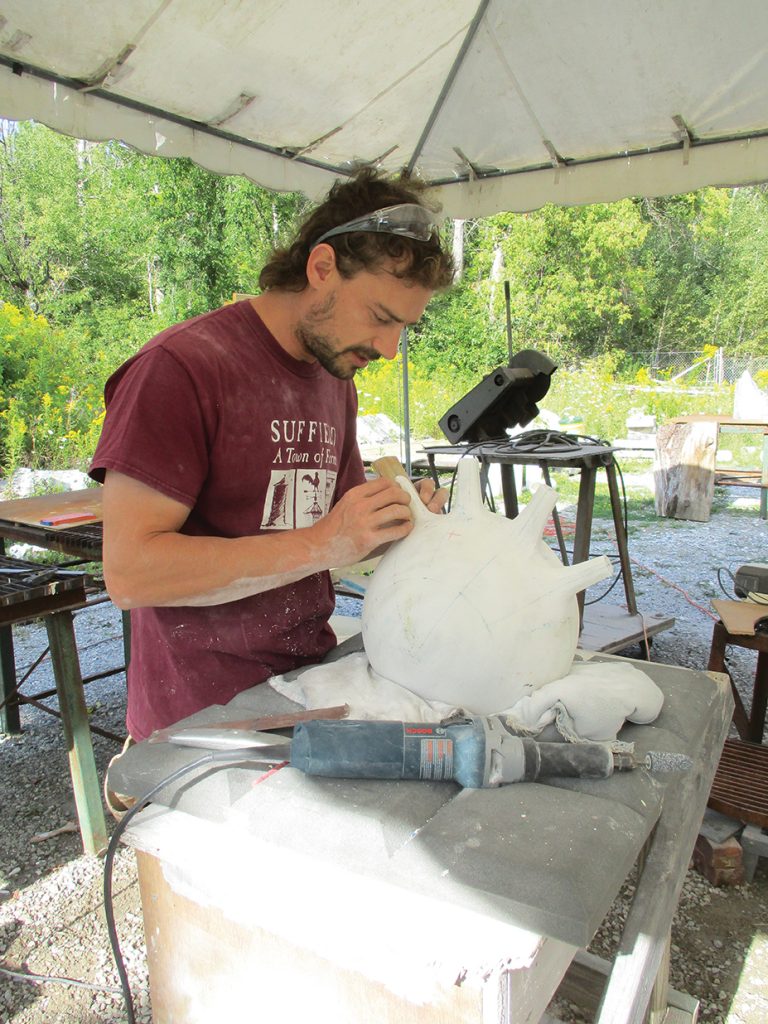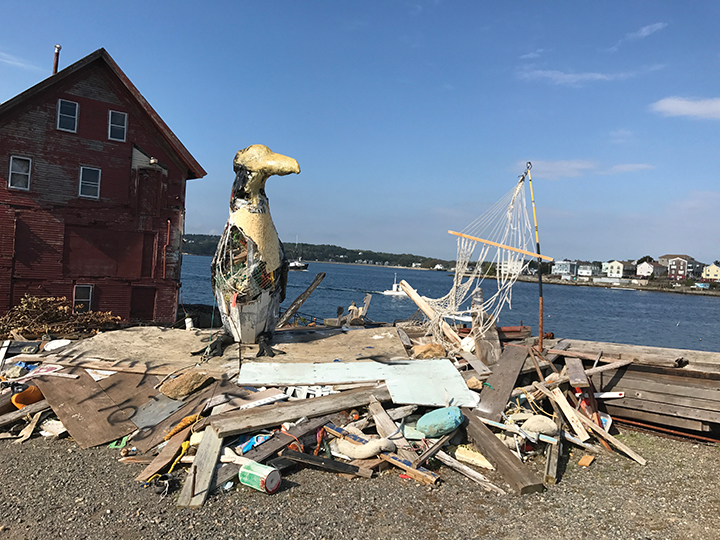Craft, Chisel, Collect
“In order to understand the world, one has to turn away from it on occasion.” Albert Camus wrote those words in his 1939 essay, “The Minotaur, or The Stop in Oran.” His was an existential treatise, yet he could have been referring to an artist residency: a chance for artists to turn away from their day-to-day worlds in order to let their creativity flourish. The ways that artists take advantage of the privileges a residency offers differ vastly, depending on the nature of the residency, the kind of work they make and their particular needs. Here, three artists share stories of their recent experiences.
SAM EKWURTZEL
Carving Studio and Sculpture Center
West Rutland, VT
At the Carving Studio and Sculpture Center, Sam Ekwurtzel was fascinated by the now-water-filled marble quarries that surrounded him. “They go down hundreds and hundreds of feet,” he said. Their depth piqued his curiosity. “I sunk caged and weighted Styrofoam forms to the bottom of the quarries,” he explained, “and let water pressure and time shrink them to varying percentages of their original size.”
Ekwurtzel, 34, is a Brooklyn, NY–based sculptor who works in his Brooklyn and Connecticut studios in assorted mediums. His practice is process-based and inquiry-driven. “I am interested in the technicalities of…making sculpture,” he said, citing bronze casting, molding and glassblowing. “Within any of those processes, there are steps that are followed. What I have been doing is taking detours midway through those steps.”
The Carving Studio is situated on six acres among a series of inactive quarries and the former—and now partially restored—manufacturing facilities of the Vermont Marble Company. Founded in 1987, it has a three-pronged mission: to run hands-on workshops, to display sculptures and to enable artists to work on-site. The summer residency program includes interns, paying residents and three to six invited artists-in-residence, such as Ekwurtzel, who are chosen by committee.
“Our aim is to make our resources available to artists,” said Carol Driscoll, the Carving Studio’s executive director. “If they are working in stone, we have a gazillion blocks they can choose from. If they are working in metal, we have a phenomenal scrapyard nearby. If they are working in bronze, we have a foundry down the road. We have a forklift. And we have people to help problem-solve.”
Ekwurtzel worked in the Carving Studio’s large outdoor yard. “There were tents set up and blocks of stone in various states of being carved, full of people hammering away, grinding away and making dust,” he said. “It was totally acceptable to walk up to somebody and interrupt them and ask for their advice.”
Which he did often. “I was interested in acquiring a new skill set,” he said. “I was looking for the right kind of tools, the right kind of support staff and specific materials.”
Ekwurtzel carved two sculptures: one in white marble, one in black limestone, each about a foot in diameter. He took a workshop given by the foundry owner, Glenn Campbell. And he worked alongside three artisans from Carrara, Italy, who were creating a 10-foot-tall marble monument of a quarry worker that will be installed in Rutland this spring.
“Proximity to the professional carvers was an opportunity to observe stone being shaped with total confidence and efficiency,” Ekwurtzel said.
The Italians brought diamond-particle grinding discs, burrs and rasps customized for carving marble—a treat for Ekwurtzel. “Previously I was using discs designed for cutting brick or chisels made for splitting granite block,” he said.
During his stay, Ekwurtzel lived in a quiet room above Mary’s Place, a white clapboard countertop diner, where he had his coffee and eggs every morning.
NATHAN THOMAS WILSON
Rocky Neck Art Colony
Gloucester, MA
During his month-long residency at the Rocky Neck Art Colony, Nathan Thomas Wilson attracted a lot of inquisitive onlookers. The artist, who lives in Brookline, MA, creates sculptural assemblages and site-specific installations using locally scavenged materials—things like construction waste, broken umbrellas, old Christmas decorations and feathers.
Wilson, Rocky Neck’s inaugural Goetemann Artist Fellow, spent last July working on the rocky mouth of Gloucester’s inner harbor, on the grounds of the Ocean Alliance. On a windy spit jutting into the Atlantic, he collected ocean debris to sculpt a great auk to memorialize the long-extinct, once indigenous flightless bird and draw attention to the increasingly polluted seas. “The piece took shape day by day based on the materials
I found,” he said.
And what materials. “A lot of it was from the fishing industry: floats and ropes and things off of boats,” he said. “There was lumber from deteriorated docks, beach balls, fishing lures, shoes, hats, shirts, pants, sunglasses, bottles, cans. Basically, anything that blows out of a trash can make its way into the ocean.”
Part of what drew Wilson, 37, to the residency was the history of Rocky Neck, a haven for painters such as Edward Hopper, Winslow Homer and Milton Avery, and for contemporary artists enticed by the light and landscape. Today, the colony has an exhibition space and hosts programs in its cultural center. Thirteen years ago, it initiated the Goetemann Artist Residency, inviting three juried residents every summer, each for one month, to live and work in the colony’s studio.
The new Goetemann Artist Fellowship is offered in partnership with a local nonprofit. “Everything Nathan did was in response to the work the Ocean Alliance does to save the ocean,” said Kathleen Gerdon Archer, director of the residency.
For Wilson, the residency presented a precious opportunity for total immersion. “I would wake up, eat something, go to the site, work until the sun went down, come back to the studio, eat something and go to sleep,” he said. “I didn’t talk or think about anything else for the entire month.”
After proposing to build his great auk at least 33 inches tall (the height of the actual bird), Wilson’s completed sculpture towers 12 feet—due to the disturbing abundance of garbage he culled from the ocean. “The sheer amount of stuff in there was shocking,” he said. “I didn’t expect to be making such a large sculpture because I had no idea I would find so much to work with.”
With its webbed feet made of sodden pipe insulation and its body an array of everything from broken crabbing cages, to soccer balls, buckets and clothes, Wilson’s great auk perched on a rock-like platform as if ready to dive into the sea. The sculpture was lit from within, so at night its beaked head glowed on the horizon like a beacon.
“There are so many lighthouses in the area,” Wilson said. “I wanted my sculpture to be like one of them. To warn people: There is danger out there.”
TANYA MONIQUE CRANE
Haystack Mountain School of Crafts
Deer Isle, ME
By the end of Tanya Monique Crane’s two-week residency at the Haystack Mountain School of Crafts, she had completed five new works. “I could never have done that at home because I would have had too many distractions,” said Crane, 43, who lives in Pawtucket, RI, and teaches at RISD and the School of the Museum of Fine Arts at Tufts.
Founded in 1950, Haystack is nestled on a remote stretch of the Atlantic coast, designed by the architect Edward Larabee Barnes to cultivate focus and discovery. Its 40-acre campus features six state-of-the-art studios for ceramics, wood, metals, glass, fiber and graphics.
The timing of the residency couldn’t have been better for Crane, a metalsmith who makes mixed-media wearable sculpture. Shortly after being accepted to Haystack’s 2017 Open Studio Residency, she received the Society of Arts and Crafts’ Artist Award, an honor that came with an exhibition at the Boston institution’s space. “I brought all my supplies so I could make as much work as possible,” she said.
When Crane applied for the residency, she envisioned an occasion to experiment. “I thought I would hop from studio to studio and play with different ideas and techniques,” she said. While her award changed that plan, Crane found a concentration she rarely achieves: “I was focused every day, the whole time.”
Haystack’s residency program, established in 2013, is fully endowed. Participants live on the grounds in cabins connected by walkways and share three daily chef-prepared meals in the dining hall.
Each studio is staffed by a knowledgeable technician. “They are not there to fabricate work for people,” said Paul Sacaridiz, Haystack’s director. “They provide a form of translation between what the artist is thinking…and how the studio operates. It’s a delicate, beautiful relationship.”
Artists also have access to Haystack’s Fab Lab, a digital fabrication facility operated in partnership with MIT’s Center for Bits and Atoms and home to 3D printers, scanners, CNC routers and other devices. Residents are afforded uninterrupted time, well-equipped workspaces and opportunities for conversations with other artists. The intention, said Sacaridiz, is “to create an environment that inspires them to think in ways they don’t often have the chance to think.”
For Crane, that meant producing work. “I stayed in the metals studio probably 80 percent of the time,” she said.
She did take a break in the ceramics studio, where she learned to make slip cast molds. And she enjoyed an impromptu dance party. She had been sitting for days, hunched over, looking down. “After a while,” she said, “you just need to move.”
But then Crane was back in the studio. She worked with shibuishi—a copper-silver alloy—which she rolled and heated to form a skin-like texture; she used an enamel sgraffito process to etch markings. One brooch pulses with concentric circles of dashes and arcs. Another sets a hashtag grid against a rounded, pockmarked field, the two contrasting sections united by a graceful, curved pin.
Susan Hodara is a journalist who writes about the arts and real estate for the New York Times and other publications. She is also a memoirist and educator.
Haystack Mountain School of Crafts
Deer Isle, ME; haystack-mtn.org
The Carving Studio and Sculpture Center
West Rutland, VT; carvingstudio.org
Rocky Neck Art Colony
Gloucester, MA; rockyneckartcolony.org
Image 1: Artist in Resident Sam Ekwurtzel uses a jig to accurately file the surface between the fingers of his inflated marble glove. Courtesy of Carol Driscoll.
Image 2: A partnership between The Goetemann Artist Residency and the nonprofit Ocean Alliance allowed Nathan Thomas Wilson, the 2017 Environmental Installation Resident, time and space to create this site-specific work on Rocky Neck in Gloucester, MA. Courtesy of the artist.
Image 3: Tanya Monique Crane, Folded Sgraffito Brooch, 4 x 3″, shibuishi alloy, copper, enamel, and steel. Hand-fabricated with sgraffito enamel process. Courtesy of the artist.



